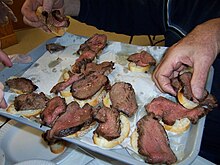Beefsteak (banquet)
[4] Early beefsteaks were held in a relaxed, men-only atmosphere, with diners sitting on crates and eating with their fingers off of rough, improvised tables in saloons, rental halls, or residential basements.
[4] Though the centerpiece of beefsteak culture was indisputably the frenzied consumption of beef and beer, with diners eating with their fingers and drinking with abandon, serving styles varied.
West Side beefsteaks tended more toward expansive menus, with courses including crab meat, lamb chops, and baked potatoes to go along with the beef loin.
Cocktails, popularized by illicit drinkers during Prohibition, replaced pitchers of beer, and "fruit cups ... and fancy salads"[4] were soon added to beefsteak menus.
By the 1930s, according to Joseph Mitchell, beefsteaks were no longer the manly, messy affairs they had once been; they were now closer to formal meals in which beef and bread happened to feature heavily.
[4] The cheerful gluttony of the past was tempered by female sensibilities; "women," Mitchell reported, "do not esteem a glutton, and at a contemporary beefsteak it is unusual for a man to do away with more than six pounds of meat and thirty glasses of beer."
Butter is sometimes replaced by margarine, and a pasta course makes an occasional appearance, but attendees at beefsteaks still expect to be fed mostly abundant quantities of beef tenderloin.
Piling them up in front of one's plate instead of consuming them "saves valuable stomach capacity for more beef while simultaneously serving as an informal scorekeeping system".
Since 2011, Chef Neal Fraser, Cort Cass, Matt Selman and Eric Wareheim have hosted a beefsteak in Los Angeles to raise money for the LA Food Bank.


